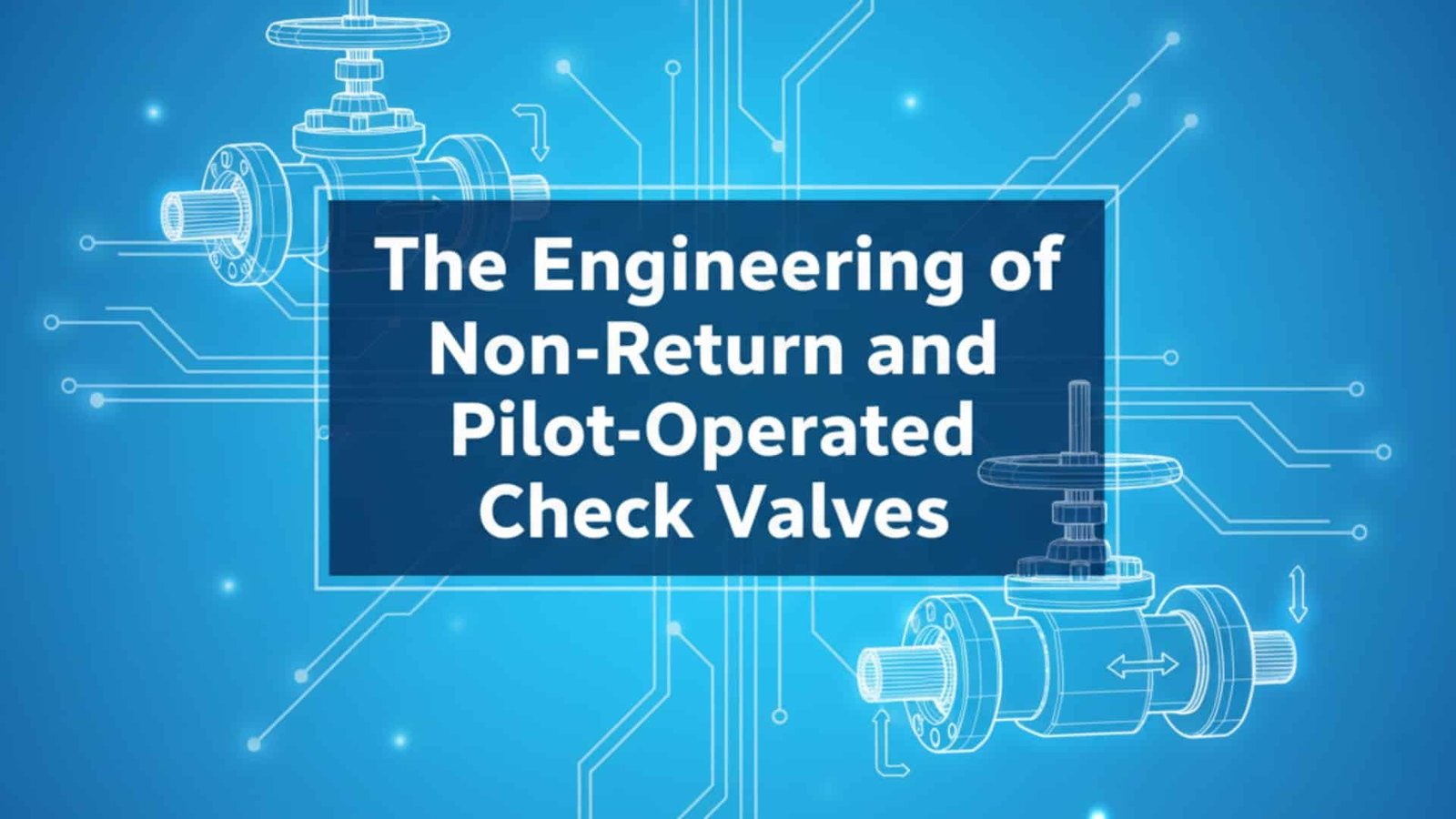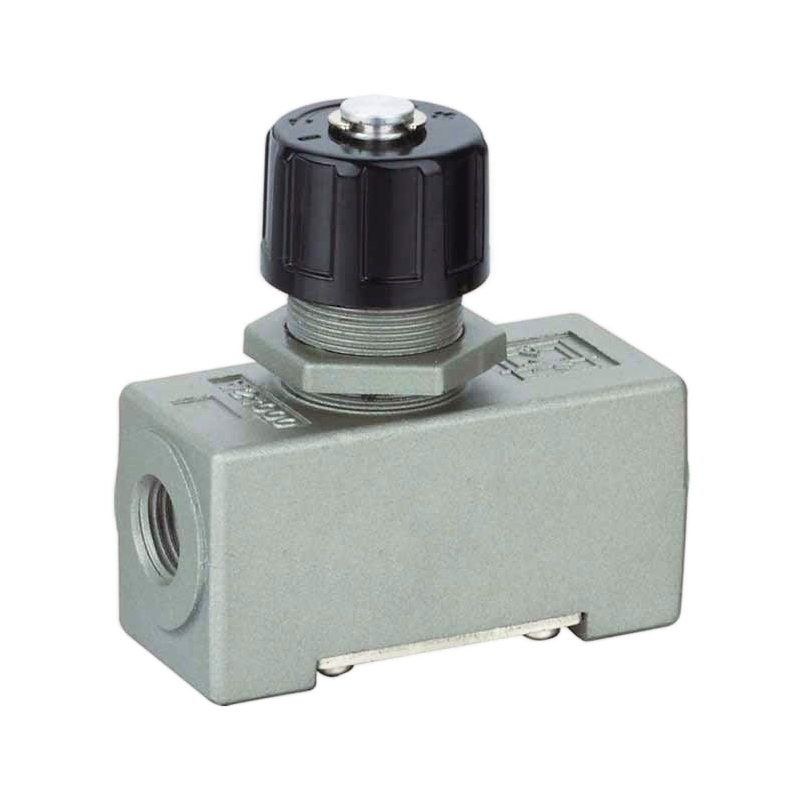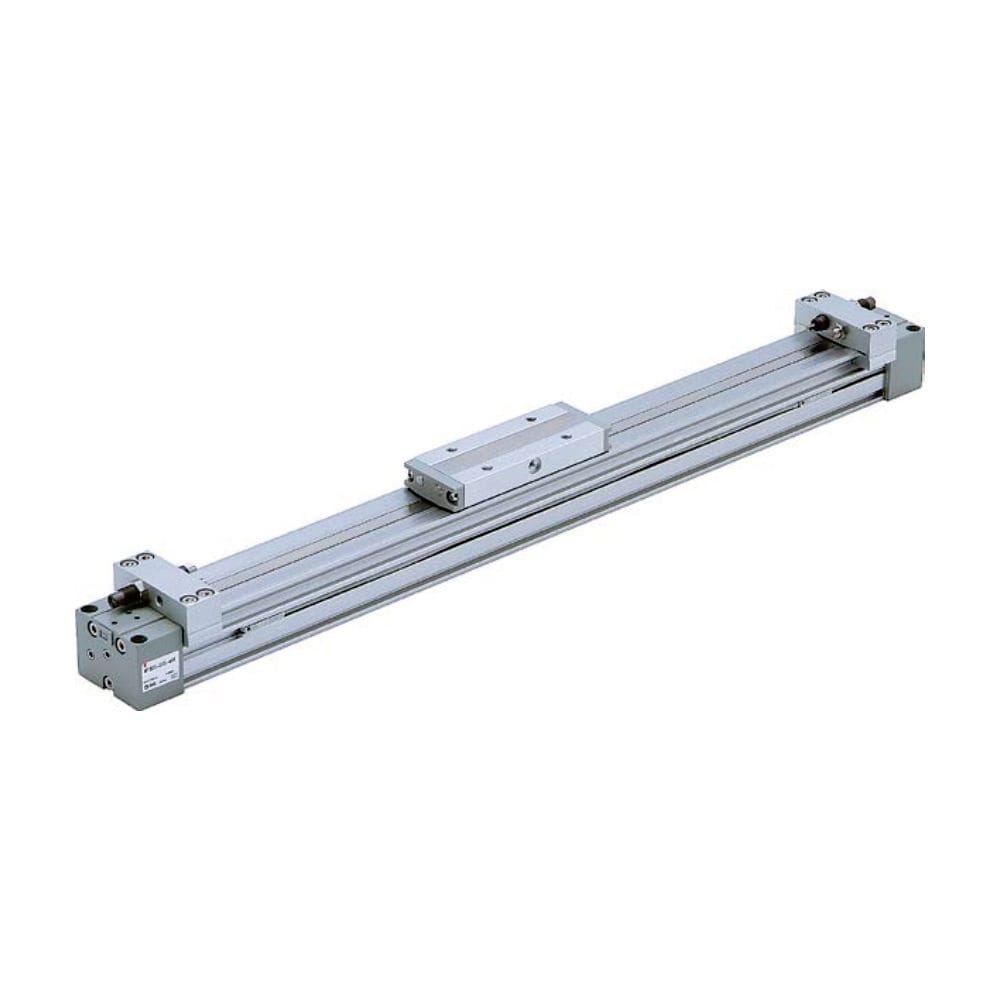Industrial systems face catastrophic failures when fluid flows reverse unexpectedly, causing equipment damage and costly downtime. Traditional check valves often fail under high pressure or create excessive pressure drops that reduce system efficiency. Engineers need reliable solutions that prevent backflow while maintaining optimal performance.
Οι βαλβίδες αντεπιστροφής και οι πιλοτικές βαλβίδες ελέγχου παρέχουν ουσιαστικό έλεγχο ροής αποτρέποντας την αντίστροφη ροή μέσω μηχανισμών με ελατήριο και συστημάτων ανοίγματος ελεγχόμενου από πιλότο, εξασφαλίζοντας την ασφάλεια του συστήματος, προστατεύοντας τον εξοπλισμό από ζημιές και διατηρώντας τις βέλτιστες συνθήκες πίεσης σε πνευματικά και υδραυλικά κυκλώματα.
Last month, I received an urgent call from Marcus, a maintenance engineer at a textile manufacturing plant in North Carolina, whose rodless cylinder system was experiencing severe pressure fluctuations due to inadequate check valve performance. 🏭
Πίνακας περιεχομένων
- What Are the Key Differences Between Non-Return and Pilot-Operated Check Valves?
- How Do You Select the Right Check Valve for Rodless Cylinder Applications?
- What Are the Common Engineering Challenges with Check Valve Design?
- How Do You Troubleshoot Check Valve Performance Issues?
What Are the Key Differences Between Non-Return and Pilot-Operated Check Valves?
Understanding the fundamental differences between these valve types is crucial for selecting the optimal solution for your pneumatic system requirements.
Non-return check valves use spring-loaded mechanisms for automatic flow control, while pilot-operated check valves combine spring operation with external pilot signals for controlled opening, offering greater flexibility and precise flow management in complex pneumatic circuits.
Βασικές αρχές λειτουργίας
Both valve types serve essential functions in pneumatic systems, but their operating mechanisms differ significantly in complexity and control capabilities.
Non-Return Check Valve Operation
- Spring-loaded design: Automatic opening based on διαφορά πίεσης1
- Simple mechanism: Minimal moving parts for reliability
- Pressure-activated: Opens when inlet pressure exceeds spring force
- Self-closing: Automatically prevents reverse flow
Pilot-Operated Check Valve Features
- Dual control system: Spring mechanism plus pilot control
- External signal: Pilot pressure overrides spring force
- Controlled opening: Precise timing of valve operation
- Enhanced functionality: Allows reverse flow when needed
Σύγκριση επιδόσεων
| Χαρακτηριστικό γνώρισμα | Non-Return Check Valve | Pilot-Operated Check Valve |
|---|---|---|
| Opening pressure | 0.5-2 PSI | 0.5-2 PSI (spring only) |
| Control method | Automatic | Manual/automatic |
| Reverse flow | Blocked always | Controllable |
| Πολυπλοκότητα | Απλό | Μέτρια |
| Κόστος | Κάτω | Υψηλότερη |
| Εφαρμογές | Βασική προστασία | Complex circuits |
Design Specifications
Our Bepto check valves feature:
- Ονομαστικές τιμές πίεσης: Up to 150 PSI working pressure
- Εύρος θερμοκρασίας: -20°C to +80°C operating temperature
- Χωρητικότητα ροής: Optimized for rodless cylinder applications
- Material options: Aluminum, stainless steel, and brass bodies
Application Advantages
Non-return check valves excel in:
- Simple protection: Basic backflow prevention
- Εφαρμογές ευαίσθητες στο κόστος: Budget-friendly solutions
- High-reliability needs: Fewer failure points
- Λειτουργία χωρίς συντήρηση: No external controls required
Pilot-operated check valves provide:
- Circuit flexibility: Controlled reverse flow capability
- Ενσωμάτωση συστήματος: Compatible with complex control systems
- Precise operation: Exact timing control
- Advanced functionality: Multiple operating modes
Marcus’s textile plant was experiencing issues with their rodless cylinder positioning system due to inadequate check valve performance. The existing valves were causing:
- Αστάθεια πίεσης: Fluctuating system pressure
- Μετατόπιση θέσης: Cylinders losing position accuracy
- Σπατάλη ενέργειας: Excessive pressure drops
- Frequent maintenance: Valve failures every 3 months
We recommended our Bepto pilot-operated check valves, which delivered:
- Stable pressure: Consistent system performance
- Ακριβής τοποθέτηση: Improved cylinder accuracy
- Ενεργειακή απόδοση: 20% reduction in air consumption
- Παρατεταμένη διάρκεια ζωής: 18 months without maintenance
The system now operates with exceptional reliability and precision. ⚡
How Do You Select the Right Check Valve for Rodless Cylinder Applications?
Proper valve selection ensures optimal rodless cylinder performance while preventing system damage and maintaining operational efficiency.
Select check valves based on system pressure requirements, flow capacity needs, mounting configuration, and control complexity, considering factors like cracking pressure, flow coefficient, and integration with existing pneumatic circuits to optimize rodless cylinder operation.
Κρίσιμες παράμετροι επιλογής
Several technical factors determine the optimal check valve choice for rodless cylinder applications and system requirements.
Σκέψεις για την πίεση
- Πίεση λειτουργίας: Match valve rating to system pressure
- Πίεση ρηγμάτωσης: Minimize pressure drop for efficiency
- Διαφορά πίεσης: Consider upstream/downstream conditions
- Περιθώριο ασφαλείας: 25% above maximum operating pressure
Απαιτήσεις ροής
- Cylinder speed: Flow capacity affects cycle times
- Κατανάλωση αέρα: Valve sizing impacts efficiency
- Πτώση πίεσης: Minimize losses for optimal performance
- Συντελεστής ροής (Cv)2: Match valve capacity to system needs
Κατευθυντήριες γραμμές επιλογής
For Standard Rodless Cylinders
- Bore size 32-63mm: Size 1/8″ to 1/4″ check valves
- Bore size 80-125mm: Size 3/8″ to 1/2″ check valves
- Bore size 160mm+: Size 3/4″ to 1″ check valves
- Εφαρμογές υψηλών ταχυτήτων: Pilot-operated valves recommended
For Precision Applications
- Ακρίβεια θέσης: Pilot-operated valves for precise control
- Συστήματα πολλαπλών θέσεων: Enhanced control capabilities needed
- Εφαρμογές σερβομηχανισμού: Low cracking pressure requirements
- Καθαρά περιβάλλοντα: Stainless steel construction preferred
Πλεονεκτήματα βαλβίδας Bepto
| Τύπος εφαρμογής | Συνιστώμενη βαλβίδα | Βασικά οφέλη |
|---|---|---|
| Βασική τοποθέτηση | Non-return check | Cost-effective, reliable |
| Έλεγχος ακριβείας | Πιλοτική λειτουργία | Enhanced accuracy |
| Κύκλοι υψηλής ταχύτητας | Low-pressure check | Minimal flow restriction |
| Σκληρά περιβάλλοντα | Ανοξείδωτο ατσάλι | Αντοχή στη διάβρωση |
Σκέψεις ενσωμάτωσης
- Επιλογές τοποθέτησης: Inline, manifold, or cartridge mounting
- Συνδέσεις λιμένων: Thread types and sizes
- Διεπαφές ελέγχου: Pilot signal requirements
- Πρόσβαση στη συντήρηση: Service and replacement ease
System Compatibility
- Existing components: Integration with current valves
- Συστήματα ελέγχου: PLC and automation compatibility
- Pressure sources: Pilot supply requirements
- Περιβαλλοντικοί παράγοντες: Temperature and contamination resistance
Sarah, a design engineer from a German automotive parts manufacturer, needed to optimize her rodless cylinder control system for faster production cycles while maintaining positioning accuracy.
Her specific requirements included:
- Cycle time reduction: 30% faster operation needed
- Ακρίβεια θέσης: ±0.1mm tolerance required
- Βελτιστοποίηση κόστους: Budget constraints for upgrades
- Reliability improvement: Reduce maintenance downtime
Our selection process delivered:
- Optimal valve choice: Pilot-operated check valves selected
- Performance gains: 35% faster cycle times achieved
- Accuracy improvement: ±0.05mm positioning accuracy
- Εξοικονόμηση κόστους: 15% lower total system cost
The optimized system has exceeded all performance targets for 8 months. 🎯
What Are the Common Engineering Challenges with Check Valve Design?
Understanding design challenges helps engineers select appropriate solutions and avoid common pitfalls in check valve applications.
Common engineering challenges include pressure drop optimization, chattering prevention, contamination resistance, and temperature stability, requiring careful material selection, spring design, and flow path engineering to ensure reliable long-term operation in demanding applications.
Design Challenge Analysis
Modern check valve design must address multiple technical challenges while maintaining cost-effectiveness and manufacturing simplicity.
Pressure Drop Minimization
- Flow path design: Streamlined internal geometry
- Valve sizing: Adequate flow area for application
- Spring selection: Minimum force for reliable sealing
- Seat design: Optimized sealing surface geometry
Chattering Prevention
- Damping mechanisms: Controlled valve movement
- Flow stability: Consistent pressure conditions
- Spring characteristics: Proper force/deflection curves
- Valve mass: Optimized moving component weight
Engineering Solutions
Material Selection Challenges
- Αντοχή στη διάβρωση: Suitable materials for environment
- Χαρακτηριστικά φθοράς: Long-term durability requirements
- Σταθερότητα θερμοκρασίας: Performance across operating range
- Χημική συμβατότητα: Resistance to system fluids
Σκέψεις σχετικά με την κατασκευή
- Tolerance control: Precise dimensional requirements
- Φινίρισμα επιφάνειας: Sealing surface quality
- Assembly methods: Consistent manufacturing processes
- Ποιοτικός έλεγχος: Testing and validation procedures
Bepto Design Innovations
| Πρόκληση | Traditional Solution | Bepto Innovation |
|---|---|---|
| Πτώση πίεσης | Larger valve size | Optimized flow geometry |
| Chattering | Heavy damping | Precision spring design |
| Μόλυνση | Frequent cleaning | Self-cleaning design |
| Θερμοκρασία | Material limitations | Advanced alloys |
Προηγμένα χαρακτηριστικά σχεδιασμού
Our Bepto check valves incorporate:
- Optimized flow paths: Minimal pressure loss design
- Anti-chatter technology: Stable operation across flow ranges
- Αντοχή στη μόλυνση: Self-cleaning valve seats
- Αντιστάθμιση θερμοκρασίας: Stable performance across ranges
Λύσεις για συγκεκριμένες εφαρμογές
- Rodless cylinder integration: Optimized for pneumatic systems
- Λειτουργία υψηλής συχνότητας: Fatigue-resistant designs
- Εφαρμογές ακριβείας: Low-hysteresis characteristics
- Σκληρά περιβάλλοντα: Protected internal components
Robert, a project engineer from a Canadian food processing equipment manufacturer, was facing recurring issues with check valve performance in his rodless cylinder systems operating in washdown environments.
His engineering challenges included:
- Contamination issues: Food particles causing valve sticking
- Απαιτήσεις καθαρισμού: Frequent sanitization needs
- Corrosion problems: Aggressive cleaning chemicals
- Reliability demands: Zero tolerance for production stops
Our engineering solution provided:
- Κατασκευή από ανοξείδωτο χάλυβα: Complete corrosion resistance
- Self-cleaning design: Contamination-resistant operation
- Sanitary connections: Easy cleaning and maintenance
- Παρατεταμένη διάρκεια ζωής: 2-year maintenance intervals
The system has operated flawlessly through 18 months of demanding service. 💪
How Do You Troubleshoot Check Valve Performance Issues?
Systematic troubleshooting approaches minimize downtime and ensure optimal check valve performance in critical pneumatic applications.
Troubleshoot check valve issues by checking cracking pressure, verifying flow direction, testing pilot signals, and examining contamination levels using proper diagnostic procedures and measurement tools to identify root causes and implement effective solutions.
Common Problem Identification
Understanding typical failure modes enables quick diagnosis and resolution of check valve performance issues.
Performance Symptoms
- Υπερβολική πτώση πίεσης: Flow restriction beyond specifications
- Reverse flow leakage: Inadequate sealing performance
- Αργή ανταπόκριση: Delayed opening or closing
- Chattering operation: Unstable valve behavior
Διαγνωστικές διαδικασίες
- Δοκιμή πίεσης: Verify cracking and sealing pressures
- Μέτρηση ροής: Check actual vs. rated flow capacity
- Οπτική επιθεώρηση: Examine valve condition and installation
- Ανάλυση συστήματος: Review operating conditions and requirements
Troubleshooting Process
Step 1: Initial Assessment
- Document symptoms: Record all observed issues
- Review history: Check maintenance and operation logs
- Verify installation: Confirm proper mounting and connections
- Διαδικασίες ασφαλείας: Implement proper lockout/tagout3
Step 2: Performance Testing
- Cracking pressure test: Verify opening pressure
- Sealing test: Check reverse flow prevention
- Flow capacity test: Measure actual flow rates
- Response time test: Check opening/closing speed
Οδηγός αντιμετώπισης προβλημάτων
| Σύμπτωμα | Πιθανή αιτία | Λύση |
|---|---|---|
| High pressure drop | Undersized valve | Install larger capacity valve |
| Reverse flow | Worn sealing surfaces | Replace valve or sealing elements |
| Αργή ανταπόκριση | Μόλυνση | Clean or replace valve |
| Chattering | Improper sizing | Adjust system pressure or valve size |
Προληπτική συντήρηση
- Regular inspection: Scheduled performance checks
- Έλεγχος μόλυνσης: Proper filtration systems
- Παρακολούθηση πίεσης: System pressure verification
- Αντικατάσταση εξαρτημάτων: Proactive part renewal
Bepto Support Services
We provide comprehensive troubleshooting support:
- Technical assistance: Expert diagnostic support
- Ανταλλακτικά: Fast delivery of genuine components
- Προγράμματα κατάρτισης: Maintenance staff education
- Βελτιστοποίηση συστήματος: Performance improvement recommendations
Jennifer, a maintenance supervisor from a pharmaceutical packaging facility in Switzerland, was experiencing intermittent check valve failures that were disrupting critical production schedules.
Her troubleshooting challenges included:
- Intermittent problems: Difficult to diagnose issues
- Κρίσιμες εφαρμογές: Zero tolerance for failures
- Πολύπλοκα συστήματα: Multiple interacting components
- Κανονιστική συμμόρφωση: FDA validation requirements
Our troubleshooting approach delivered:
- Systematic diagnosis: Comprehensive problem analysis
- Root cause identification: Contamination source located
- Permanent solution: Upgraded filtration system installed
- Υποστήριξη επικύρωσης: Complete documentation provided
The system has operated without failures for 12 months following our intervention. ⚡
Συμπέρασμα
Proper engineering and selection of non-return and pilot-operated check valves ensures reliable pneumatic system operation, optimal rodless cylinder performance, and long-term cost savings through reduced maintenance and improved efficiency.
FAQs About Check Valves
Q: What is the typical cracking pressure for pneumatic check valves?
Most pneumatic check valves have cracking pressures between 0.5-2 PSI, with low-pressure versions available for sensitive applications requiring minimal pressure drop.
Q: Can pilot-operated check valves work without pilot pressure?
Yes, pilot-operated check valves function as standard check valves when no pilot signal is applied, using only their internal spring mechanism for operation.
Q: How do you prevent check valve chattering in high-flow applications?
Prevent chattering by proper valve sizing, maintaining stable upstream pressure, using appropriate damping, and selecting valves with optimized spring characteristics for your flow range.
Q: What maintenance is required for pneumatic check valves?
Regular inspection for wear, contamination cleaning, pressure testing, and replacement of sealing elements based on operating conditions and manufacturer recommendations.
Q: Are stainless steel check valves worth the extra cost?
Stainless steel valves provide superior corrosion resistance and longer service life in harsh environments, making them cost-effective for demanding applications despite higher initial cost.





